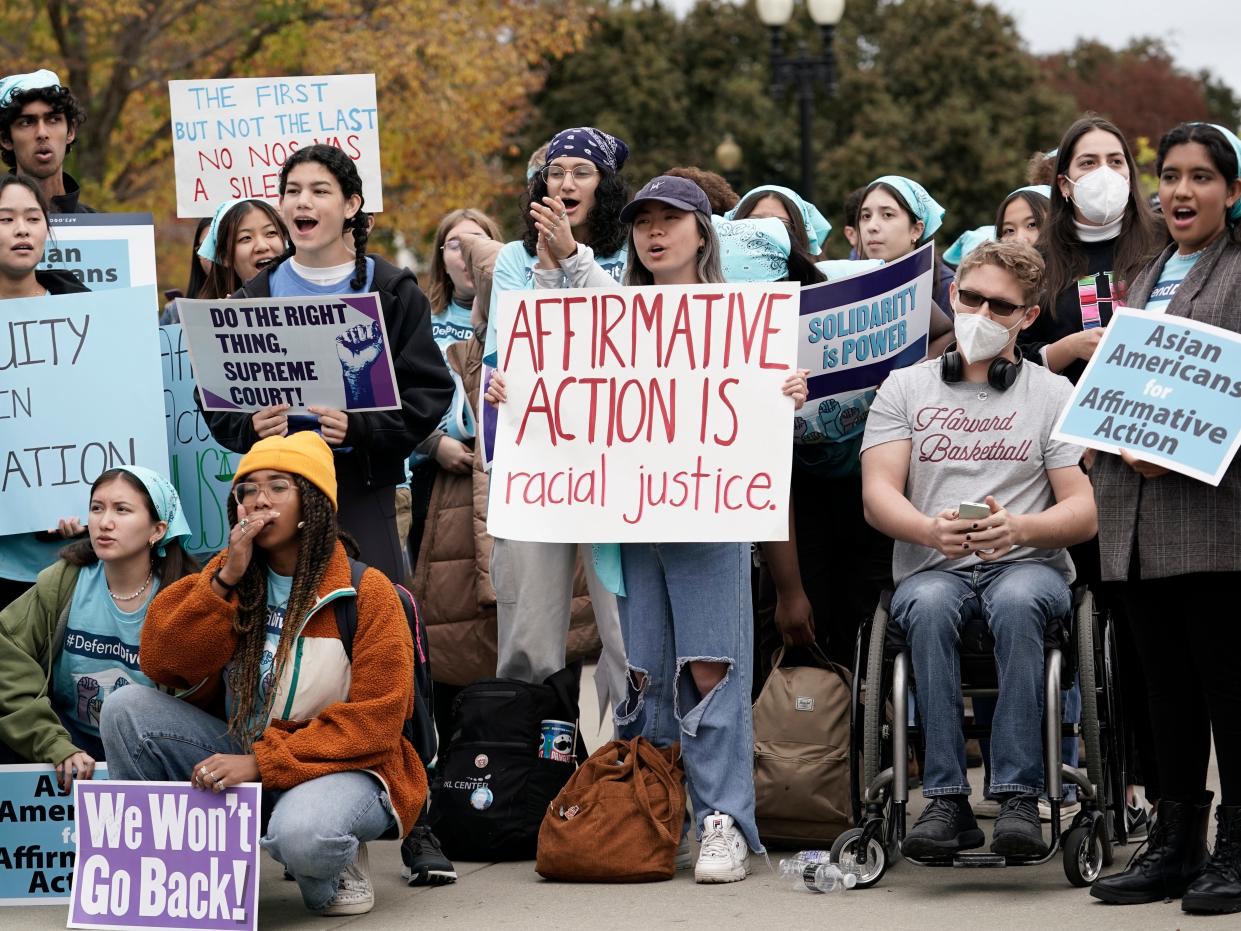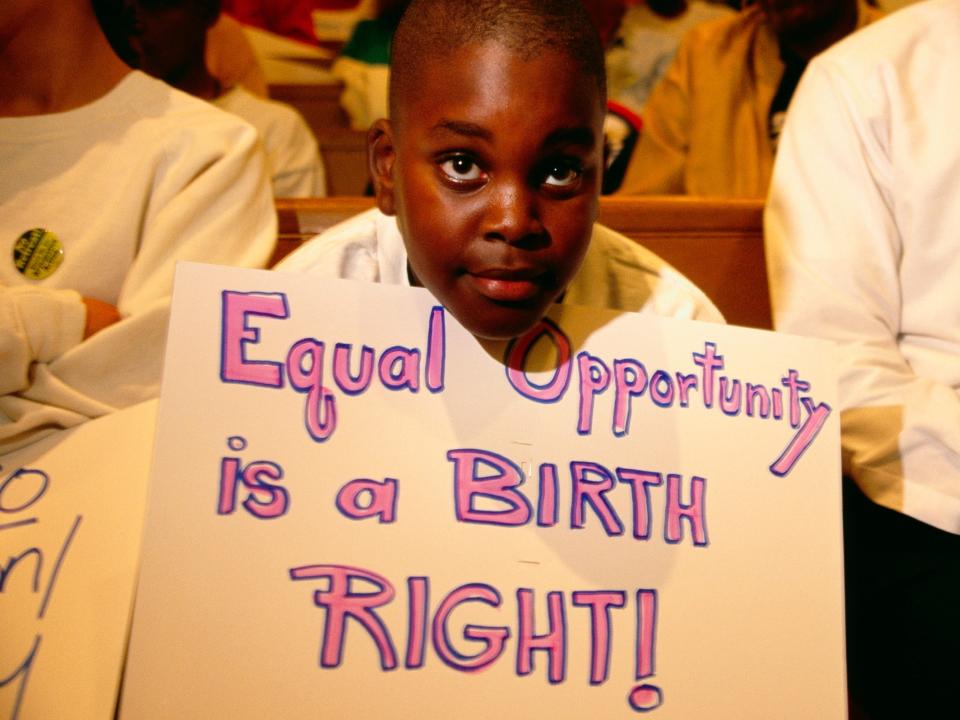By striking down affirmative action, the Supreme Court put forth a dangerous and false ideal of 'colorblindness'

- Oops!Something went wrong.Please try again later.
- Oops!Something went wrong.Please try again later.
On June 29, the Supreme Court voted to end race-based college admission policies.
In her dissenting opinion, Justice Sotomayor lambasted the Court for cementing a "superficial rule of colorblindness."
By ignoring the realities of race, a colorblind approach can be harmful to communities of color.
The Supreme Court's controversial decision to end race-based affirmative action policies is setting a precedent that will ricochet across public and private colleges and universities across the country.
The 6-3 decision, predictably, was split among racial lines, with the exception of Justice Clarence Thomas. Thomas joined his five white, conservative justices in the majority opinion, which ruled that Harvard University and the University of North Carolina's race-based admission policies were unconstitutional.
In a biting dissenting opinion, Justice Sonia Sotomayor lambasted her colleagues on the bench for ignoring the realities of race in the US.
"The Court cements a superficial rule of colorblindness as a constitutional principle in an endemically segregated society where race has always mattered and continues to matter," Sotomayor wrote.
"The devastating impact of this decision cannot be overstated. The majority's vision of race neutrality will entrench racial segregation in higher education because racial inequality will persist so long as it is ignored."
Sotomayor and Thomas are both the likely beneficiaries of affirmative action. Sotomayor, who is Latina, and Thomas, who is Black, both attended Yale Law School, though both have spoken differently about their experiences. While Sotomayor has referred to herself as "the perfect affirmative action baby," Thomas has expressed that he believed "racial preference had robbed [his] achievement of its true value."
Just like Sotomayor, Thomas also referred to colorblindness in his own 58-page opinion, writing that race-based admission policies "fly in the face of our colorblind Constitution and our nation's equality ideal."
Colorblindness has become a prominent school of thought, especially in the educational sphere, sometimes used as a counterpoint to concepts like critical race theory, which teaches that systemic racism is a part of American history and society.
Advocates for colorblind rhetoric often argue that overlooking racial differences will lead to students of all racial and ethnic backgrounds growing up in symbiotic harmony. "I don't see color" is a common refrain among prominent white professionals and personalities — everyone from ex-Starbucks CEO Howard Schultz to conservative commentator Tomi Lahren have uttered a version of it.
But who does a colorblind approach really benefit?

An educational system built for white Americans
In the US, around 79% of public school teachers are white. They are teaching a student body that is 53% non-white. According to Pew research from 2021, there is not a single state where a teacher is less likely to be white than their students. They are also teaching from a curriculum that is predominantly focused on white authors, and one that often tells a whitewashed version of history.
The majority of white Americans (57%) disapprove of colleges taking race and ethnicity into consideration in admissions, compared to 29% of Black Americans and 39% of Hispanic Americans. Yet, white women have arguably benefitted the most from affirmative action — gender provisions that were first implemented in the 1960s and 70s have aided in making this generation of women the most educated in history and the most involved in the workforce (women account for nearly 52% of all management and professional-related occupations in the US).
From birth through every step of their educational journey to career advancement and retirement, the US is built primarily for white Americans to succeed. Given that, ignoring the realities of racism does not serve communities of color.
Colorblindness only benefits white people, saving them from the discomfort of having to grapple with the role their own racial identity played in their successes. It allows them to minimize or fully dismiss the extent of harm caused by discrimination. In a colorblind world, the onus of having to confront these daily realities is solely the burden of communities of color who are told they must suffer in silence.
When colorblindness becomes codified into law, we risk rolling back decades of progress.
Constitutional colorblindness
This colorblind approach to the law isn't new. For years, conservatives on the Court have weaponized a colorblind reading of the Constitution, arguing that race cannot be legitimate grounds for legal distinctions. By this reading, all race-conscious laws must be thrown out for being unconstitutional.
At one point in history, colorblindness was harnessed by progressives, who relied on a colorblind constitutionality to fight for equal rights for Black Americans. In 1896, in the dissenting opinion for Plessy v. Ferguson, the case that instituted the "separate but equal" doctrine, Justice John Marshall Harlan made an argument for desegregation, writing, "Our Constitution is colorblind and neither knows nor tolerates classes among citizens."
However, in recent years, constitutional colorblindness has become a sacred touchstone for conservative originalists on the Court, including the late-Justice Antonin Scalia, as well as Justice Thomas.
In Parents Involved v. Seattle School District in 2007, Chief Justice Roberts made the argument that public school districts cannot use race to assign students to schools as a means of integration, writing, "the way to stop discrimination on the basis of race is to stop discriminating on the basis of race."
A colorblind reading of the Constitution that once argued for desegregation in the case of Justice Harlan's dissent was now being used to argue against desegregation.

An imperfect system
In the majority opinion for the cases against Harvard and the University of North Carolina, Chief Justice Roberts argued that the colleges' affirmative action programs were too broadly implemented, sometimes boiling down to racial stereotyping: "By grouping together all Asian students, for instance, respondents are apparently uninterested in whether South Asian or East Asian students are adequately represented, so long as there is enough of one to compensate for a lack of the other," Roberts wrote. "Meanwhile other racial categories, such as 'Hispanic,' are arbitrary or undefined."
Affirmative action is an imperfect system. Even its most ardent proponents and its beneficiaries don't argue otherwise. In a statement following the ruling, former president Barack Obama wrote, "Like any policy, affirmative action wasn't perfect. But it allowed generations of students like Michelle and me to prove we belonged."
The solution to those shortcomings, however, is not to ignore race altogether. Roberts accused the colleges' affirmative action programs of "employ[ing] race in a negative manner" without any "meaningful end points." However, the impact of not taking race into consideration has already proven to be more devastating for college enrollment.
Colleges that have already stopped considering race in admissions in places that have state-level bans, like California and Idaho, have reported enrollment drops among Black and Hispanic students, especially at highly selective and historically white schools.
After a statewide ban in 1996, University of California, Berkeley and UCLA saw Black and Hispanic enrollment drop by half within only two years. Now, more than 25 years after the ban, school officials say they still haven't been able to meet their diversity and equity goals.
In an amicus brief submitted to the Supreme Court in support of race-based admissions programs, University of California chancellors wrote, "Despite its extensive efforts, UC struggles to enroll a student body that is sufficiently racially diverse to attain the educational benefits of diversity." UC claims to have spent more than a half-billion dollars on outreach efforts to improve diversity since 2004.

The benefits of diversity
In her own statement following the ruling, Michelle Obama reflected on her years at Princeton and Harvard as one of the only Black students, afraid that others may have believed she found herself on campus only because of affirmative action: "It was a shadow students like me couldn't shake."
But then, she goes on to list special considerations other students were given that granted them admission: children of alumni, athletes, students who had access to tutors and test prep.
"So often, we just accept that money, power, and privilege are perfectly justifiable forms of affirmative action, while kids growing up like I did are expected to compete when the ground is anything but level," she wrote.
Diversity doesn't only benefit communities of color — studies have shown that racially diverse groups are more innovative and more productive. In an article for Scientific American, Columbia Business School professor Katherine Phillips makes the case that diversity increases creativity, and the addition of new perspectives leads to better problem solving. Studies have also shown that diverse juries were better at considering case facts and were more diligent and open-minded.
"Diversity jolts us into cognitive action in ways that homogeneity simply does not," Phillips wrote.
Michelle Obama echoed that same sentiment based on her own college experience. "Every student who heard a perspective they might not have encountered, who had an assumption challenged, who had their minds and their hearts opened gained a lot as well," she wrote about the benefits of diversity driven by affirmative action.
"It wasn't perfect, but there's no doubt that it helped offer new ladders of opportunity for those who, throughout history, have too often been denied a chance to show how fast they climb."
Read the original article on Business Insider

